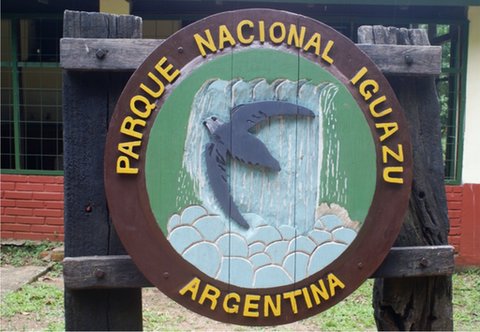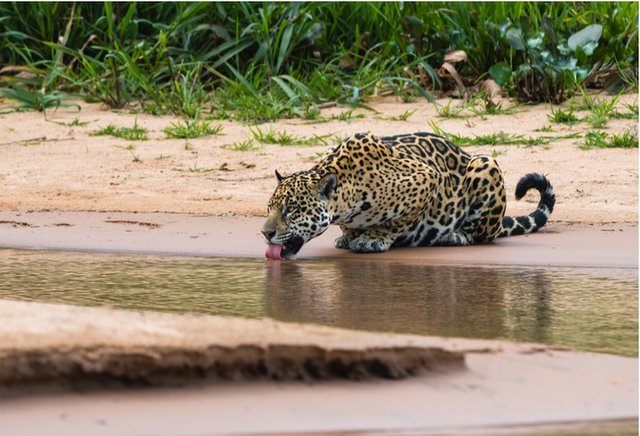PeopleandtheFalls
Peoplehavelivedinthisareaformorethan10,000years.First,theKaingang.Then,theGuaraní.In1541,SpanishexplorerÁlvarNúñezCabezadeVacawasthefirstEuropeantoseethe falls.
Religiousmissionariesarrivedin1609.But,theSpanishforcedthemtoleavein1767.Itwasn’tuntiltheearly1880sthatWesterninterestsurfaced again.
Followingascientificexpeditiontothearea,thefirsttouristtripwasorganizedin1901.Thefirstnationalpark,IguazúNationalPark,openedin1934.Five yearslater,itssisterparkopenedinBrazil.BothareUNESCOWorldHeritagesites.AndIguazúFallsisoneofthe“NewSevenWondersof Nature.”
InArgentina,peoplespeakSpanish.So,thefallsarecalledtheIguazúFalls.InBrazil,theyspeakPortuguese.So, theycallthemtheIguaçuFalls.

Thissignsays,"IguazúNationalPark,Argentina"in Spanish.
TroubleinParadise
PeoplewanttoprotecttheIguazúregion.Yet,peopleareitsbiggestproblem.Poacherscomeintotheparksillegallytotaketreesandanimals.Peopleaccidentallyinjureorkillanimalswhiledrivingthroughthe parks.
Outsidetheparks,loggingandclearinglandforfarmsaretwoofthebiggestproblems.Whentreesdisappear,plantsandanimalslosetheirhomes.Somespeciesgoextinct.WatersourceslikeIguazúFallsareaffected, too.
Peoplealsobuilthydroelectricdamsinthearea.Thedamshelpsupplyelectricitytothearea.Buttheyalsoaffectthewaterlevelinthe rivers.

TheItaipuDamontheupper ParanáRiverisoneofthelargesthydroelectricprojectsinthe world.
TouriststakeaboattourofIguazú Falls.
Morethan1.5milliontouristsvisitthefallseachyear.Theregiondependsonthetouriststosurvive.Ifthefallsrundryorplantsandanimalsdisappear,peoplemaynolonger come.
WorkingTogether
OnechallengeinpreservingtheIguazúFallsregionisitslocation.Thefallsarenearthebordersofthreecountries.Eachhasitsownideasonhowtomanagetheland.ArgentinaandBrazil,forexample,establishednationalparksinthe1930s.Paraguaynever did.
Thesecountriesdisagreeaboutdams.Yet,theyhavecometogethertocreateaplanonhowtomanagetheland.Thisincludesmorepatrols,speciesmonitoring,education,and research.
Recently,jaguarsbecameasignthattheplanisworking.Intheearly2000s,jaguarshadnearlydisappearedfromthisregion.Thecountriesincreasedpatrols.Theyplantedcameratrapstodeterpoachers.Farmerswhousedtokilljaguarsthatpreyedontheirlivestockstartedplantingcorninstead.Asaresultoftheseactions,thenumberofjaguarshas doubled.

JaguarsaremakingacomebackintheIguazú region.
People’seffortstomaketheparksbetterareworking.ThebeautifulfallsandotherIguazúsplendorsareworthseeing.Andtheyareworthfighting for.
Thisviewfromabove showspartofthespectacular falls.
